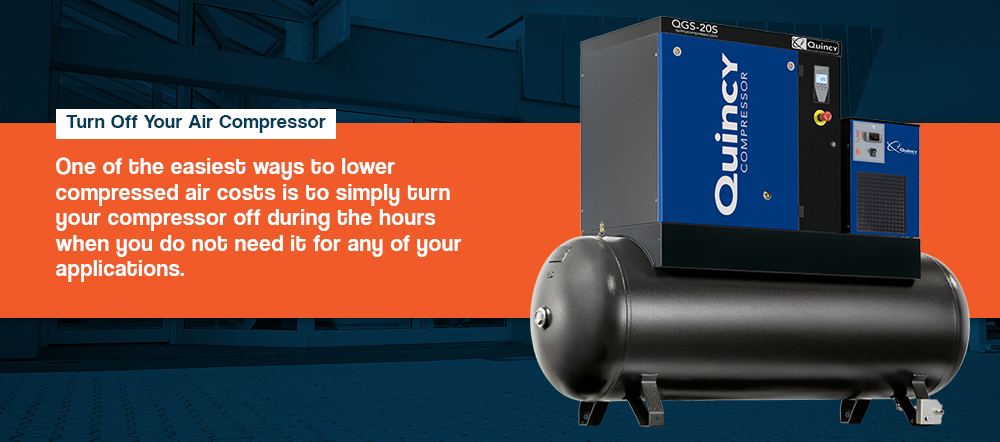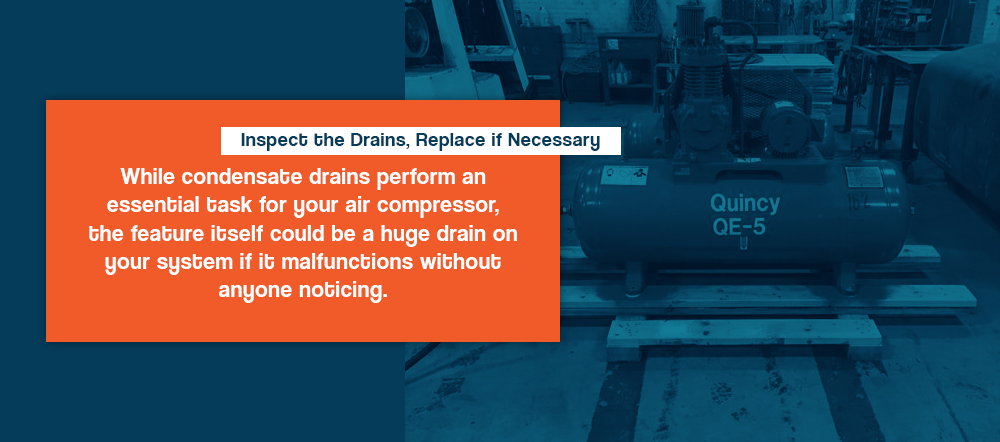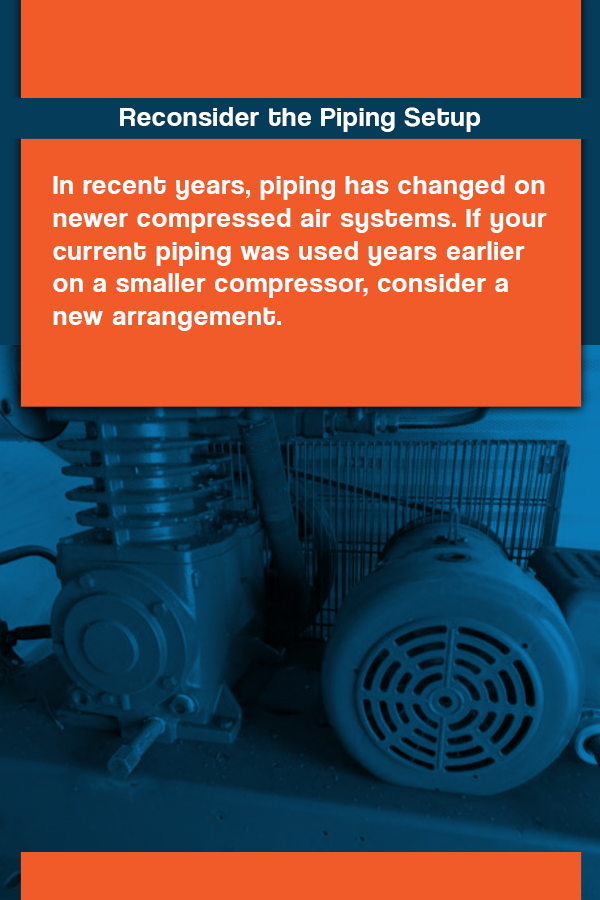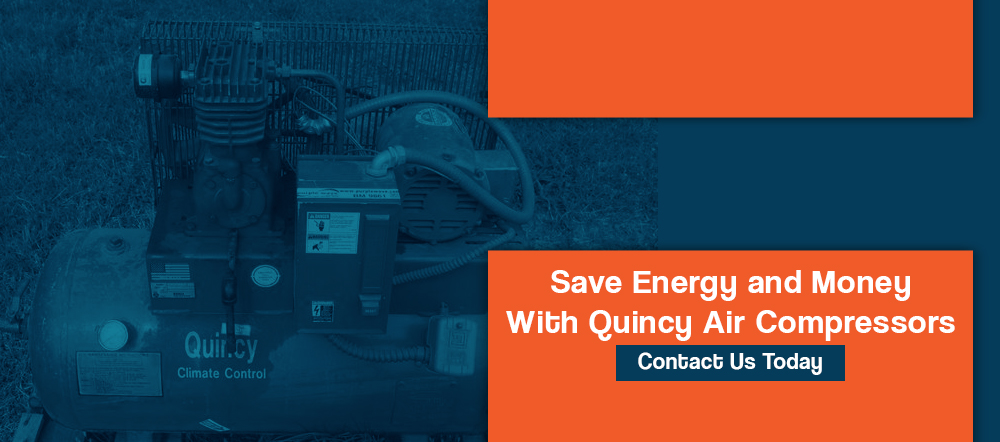Air compressors use considerable volumes of energy during a typical work cycle. When you add up all the expenses of operating a facility, any savings can help you boost your bottom line. With air compressors, savings come down to efficiency, which depends on a steady maintenance regimen. The following 18 ways to reduce compressed air costs can help you increase your productivity, boost your earnings and prevent costly repairs and system downtime.
1. Turn Off Your Air Compressor

One of the easiest ways to lower compressed air costs is to simply turn your compressor off during the hours when you do not need it for any of your applications. To a lot of people, this might seem like a piece of anti-advice. After all, this article is about how to lower compressed air costs and be productive with pressurized air. How would shutting off the compressor help you achieve that goal? The thing is, a lot of people keep their air compressors idling during off-hours, oblivious to the fact that this wastes energy.
Think of it this way. A calendar week consists of 168 hours. Unless you actually use your compressor for processes that run nonstop, 24/7, there is no reason to have your compressor running every hour around the clock. If you only use the compressor for eight, 10 or 12 hours per day, five days per week, you would only need to have the compressor on between 40 and 60 hours in a given week. By cutting the hours of usage down to a typical working week, you could cut your energy consumption down by two-thirds and see significant savings in your subsequent energy bills.
2. Repair Existing Leaks
To save money on compressed air costs, it is crucial to eliminate air leaks as much as possible. With air compressors, four-fifths of the energy consumed in a given cycle turns to heat, and only the remaining 19 percent yields air power. When leaks and other performance issues plague the compressor, the overall efficiency drops even lower than that one-fifth level. It is, therefore, essential to inspect your compressed air system for leaks regularly and perform maintenance when necessary.
Most leaks are hard to detect because they are either located in hard-to-access spots or the rupture is not large enough to be audible at arm’s length. Depending on the scope and magnitude of your operations, the costs associated with air leaks could spill into the four- or five-figure range each year. The most effective way to reduce leaks is to use an ultrasonic leak detector, which can detect some of the smallest and faintest leaks. With a leak detector, you can spot and remedy leaks in their formative stages before they expand and lead to costlier problems.
3. Stop the Formation of New Leaks
To consistently achieve lower compressor energy costs, you must perform anti-leak preventative maintenance regularly. During each inspection, leave no stone unturned in your efforts to prevent the formation of leaks. When it comes to stopping leaks, you must look at various parts of the system, both inside and out, because various problems can result in new leaks.
The first place to check is the pipes, which could be vulnerable to cracks if corrosive elements are allowed to deposit along the length of a given pipe or any of the connecting points. If you spot dust particles or sludge around the piping, clean these spots as thoroughly as possible. To keep each surface in optimal condition, you must keep each pipe clean and dry.
During these inspections, check the filters and drains to ensure that no dust or water accumulates within the system. When mist and dirt get trapped within the compressor and deposit on various internal parts, corrosive gunk can take hold and lead to rust, leaks and system strain.
4. Lower the Air Pressure
Even when your system is free of leaks and dirt, you can cut compressed air costs even further by reducing the pressure to the levels required for a given operation. At many facilities, pressure levels are set to maximum thresholds to accommodate the highest-pressure applications. The trouble is, these high-pressure tools and applications might only account for a fraction of the air-powered arsenal.
The system creates back pressure, which the compressor must pump against, and when the compressor delivers more air than demand requires, pressure rises. Anything forcing the pressure higher than necessary creates wasted energy, which can be exponential — the main contributors are artificial demand and compressor size.
Increased pressure boosts air demand from all unregulated users, creating artificial demand. Artificial demand can easily account for an additional 100 standard cubic feet per minute (scfm) of demand or another 25 hp. If increased demand requires an additional compressor, the power increase will be disproportionate. If the backup compressor were 200 hp, the online horsepower would likely increase by 100 hp or more.
About 25%-30% of horsepower in most systems originates from unnecessarily high pressure. Identifying and correcting applications driving higher system pressure lets you turn off compressors or change your setup. If you only use high-pressure tools on a part-time basis, consider the possibility of separating those tools from the rest of your equipment. This way, you could run your compressor at medium pressure and save energy through most of your working hours and only increase the pressure when necessary.
If you operate a large facility with multiple compressors, designate each machine for different pressure levels. For example, if you have a range of lower- or medium-pressure applications and only one or two that require high pressure, you could save energy by moving those latter applications to a second compressor specifically designated for such tools.
5. Inspect the Drains, Replace if Necessary
While condensate drains perform an essential task for your air compressor, the feature itself could be a huge drain on your system if it malfunctions without anyone noticing. On air compressors with timer drains, the drain valve will automatically open each time the timer goes off. If the machine is inactive when this occurs, the timer drain will start up the motor for a short time. Consequently, the drain could often inflict excess wear and tear on your system, just so the drainage process can occur according to schedule.
Further problems could arise if the timer drain gets stuck in the open position. Depending on the placement of your air compressor and the maintenance schedule of your staff, an open drain door might go unnoticed for several weeks or months. That whole time, compressed air will inevitably leak from the system.
To get around this problem, use a zero-loss drain. This way, your system will not be vulnerable to air loss each time you drain the system. By investing in a zero-loss drain, you can save in the long run by preventing the air loss and maintenance costs that will mount over time due to the problems associated with timer drains.
6. Reconsider the Piping Setup
The piping for your air system should be wide enough to allow optimal flow and reduce pressure drop. At the same time, pipes should travel the shortest possible distance to reduce the length of flow, as lengthy flow increases the possibility of pressure drop. With wider pipes, you can cut pressure drop in half because the air can travel faster and retain its original pressure.
Pressure drop is liable to increase when the routing is lengthy and complicated. The longer each flow must travel, the more the pressure drop will be by the time the air reaches its end-point destination. If the pipes are changed in a way that doubles the flow, the pressure drop could increase four-fold. Consequently, your pneumatic processes would be rendered weaker, and the system overall would be less efficient because of tight, lengthy piping.
In recent years, piping has changed on newer compressed air systems. If your current piping was used years earlier on a smaller compressor, consider a new arrangement. If your pipes are smaller than the outlets on your compressor, trade up to a new set of pipes that are wider in diameter. Rather than complicate matters, arrange your pipes so that the flow is wide and as short as possible.
7. Clear the Filters and Replace When Necessary
To further cut compressed air operating costs, clean the filters throughout your system on a regular basis. On each unit, the filters play a critical role in the process of the system by capturing dust and dirt from the incoming air. This way, the ambient air is free of air-bound particulates by the time it enters the pressurization chambers. Without the filters, the pressurized air would likely be contaminated and rendered far less effective for pneumatic applications. Moreover, dust and dirt would filter through the air compressor and accumulate on various internal parts.
Depending on the volume and frequency of your operations, each filter should be cleaned on a weekly or monthly basis. Make sure that all dirt is removed before you restart the compressor. Additionally, clean any secondary filters, such as air-line or point-of-use filters situated outside the compressor room or away from the actual units. When a filter appears worn or soiled with residue, change out the filter with a matching replacement.
8. Recover Heat
There are ways to reduce compressed air costs and also salvage the heat that your compressor generates during operations. Most of the energy that powers your compressor ultimately becomes heat, while a relatively small portion translates to pressurized air. However, the energy that turns to heat can be salvaged and put to different uses.
To make use of the heat that emits from your air compressor, equip your system with attachments designed to convert the heat for other purposes. With a water-cooled unit, you can use the heat to produce hot water, which could be used for other purposes within your facility. If you have a radiator-cooled unit, you could convert the heat into ambient warmth, which could then be directed to the parts of your facility that need heat during certain times of the year.
In any case, beware of heating issues in the summer months. If an air compressor gets too hot, the lubrication on the internal parts could lose its viscosity and cause corrosion to take hold.
9. Conduct and Schedule Maintenance
When it comes to the operation of your system, one thing is certain — maintenance amounts to savings on compressed air operating costs. To maximize the functions of your air compressor, you must inspect the unit on the outside and inside periodically. In addition to the pipes and filters, you should regularly inspect the motor fans, drip tray, belt and lubrication.
The fans in your air compressor perform a crucial function by lowering the heat inside your unit. To keep the fans fully functional, check the blades for dirt or lint. If one of the blades appears dull or cracked, trade out that fan for a newer duplicate.
Each time you open up the air compressor, inspect the belt to make sure that it has the proper flex to function properly. Give the belt a slight pull to test its elasticity and run your finger across the side for signs of cracks or dullness. When you check the lubrication, make sure that it has the proper color and viscosity. If the machine has been excessively hot, the lubrication could melt and leave the internal parts vulnerable to grinding and rust.
10. Identify and Eliminate Wasteful Uses of Compressed Air
An engineer who knows how to save on compressed air costs will work to eliminate wasteful uses of pressurized air. Regardless of the size of your facility, it is crucial to know the pressurization requirements for the applications at hand and the amount of energy needed to make it all possible. Otherwise, extraneous uses of energy could eat into your profit margin.
In some cases, various minor acts of compressed air usage can amount to wasteful behavior. For example, if pneumatic blowers are used by factory floor personnel to dust off tables and shelves, air power is being consumed for a function that could just as easily be performed with manual brushes.
In other cases, extraneous compressed-air usage can quickly become a costly habit. For example, if air blowers are being used to cool the interior of an industrial facility, you could be faced with soaring energy costs over a function that would be much better achieved with fans or an air conditioning system.
11. Recognize Pressure Losses
Find out which applications are most sensitive to pressure fluctuations. If a compressed air application is not performing correctly, the compressor operating arrangement or pressure is usually adjusted. This “minimum acceptable standards” approach doesn’t examine the process to determine what may have changed but compensates for all problems with increased system pressure.
You can increase the pressure at the article by:
- Raising the system’s pressure: This is easiest but most expensive. Every increase of 1 pound per square inch (psi) in systems pressure raises the required online compressor horsepower by 0.5%. So, if you operate a 500 hp system and raise the header pressure by 10 psi to overcome an application problem, an increase of 5% or 25 hp is expected.
- Decreasing the pressure losses: This involves analyzing pressure losses and reducing the losses between the compressors and the article pressure. There’s generally over 30 psi of pressure loss from the header pressure to the reliable article pressure, a portion of which relates to inadequate capacitance.
12. Locate the Pressure Drop
An accurate delta pressure measuring instrument will measure the pressure drop on an intermittent application. Observing the regulator gauge gives a general idea of the delta pressure.
The difference between the regulator’s static setpoint and the stable pressure when the application is flowing will approximate the pressure loss. The results usually indicate that point-of-use components like the filter, regulator and lubricator (FRL) and final hoses will easily and significantly reduce pressure losses.
Pressure loss from these components can be as high as 25-30 psi. This is true frictional loss due to flow resistance and therefore depends upon the application’s pressure, temperature and flow rate. However, these components are normally sized to match the connecting pipe and not selected based on acceptable pressure loss.
For example, at 90 pounds per square inch gauge (psig) and 40 scfm, a standard ½-inch FRL causes over 18 psi of pressure loss. On an application determining the system’s operating pressure, a different approach is warranted. Higher-quality components are available in the same nominal size with lower-designed deltas.
Standard components can be oversized by one or two nominal sizes to achieve a similar result. Designing a total point-of-use component pressure loss of <6 pounds per square inch differential (psid), allowing filter dirt loading to increase the delta to 10 psid, is recommended.
13. Perform a Flow Rate Analysis
The analysis must be based on flow rate and not average consumption. The flow rate is the volume required in a specific period, corrected to scfm. If a device uses 4 standard cubic feet in six seconds once a minute, the average consumption would be four scfm, and you could improperly install ½-inch components expecting minimal pressure loss.
However, the flow rate here is calculated as (4 scf x 60 secs / 6 secs = 40 scfm) and will generate the >18 psi pressure loss discussed above. To obtain this flow rate from a pneumatic equipment manufacturer, ask specific questions — they will always quote the average consumption rate and not the highest flow rate at any specific time.
Reducing pressure losses allows a more reasonable operating pressure and reductions in online compressor horsepower. As compressed air system storage is a function of the receivers’ physical size plus the piping and useful pressure differential, reducing system pressure decreases storage capability.
14. Rearrange the Air Receivers
In a compressed air setup, the size and placement of the air receiver is a major determining factor in the overall operating cost of the system. For each successive pressurized air supply, the air receiver functions as a placeholder between the compressor and the system at large. Within the air receiver, the pressure is modulated to suit the demands of the application at hand.
In some factories, technicians place the air receiver before the air dryer. This way, lingering traces of oil and condensate are removed from the process before it reaches the dryer. The downside to this arrangement is that the receiver is forced to hold denser supplies of air. If the demand surpasses the capacity rating, the dryer might get overloaded and increase the dew point pressurization.
The other option is to place the receiver after the dryer. This way, spikes in demand are received with dry air. For protective purposes, the ideal arrangement is to affix the supply side with two receivers. In this arrangement, the first receiver controls condensate dropout while the second handles varying demand levels.
15. Choose the Right Dryer and Filter
The importance of drying pressurized air is generally a misunderstood concept, even among people who mostly understand how to lower compressed air system costs. Consequently, the systems put in place for this purpose are often inefficient. One of the most frequently asked questions about filters and dryers concerns whether desiccant or refrigerant types are best. The question is usually followed by further inquiries regarding regulators, lubricants and filtration levels.
Before these questions can be answered, the applications of your compressed air system must be taken into account. For example, the level of your drying needs could depend on whether you operate in a humid environment. That said, certain principles apply in all cases. For starters, never allow pressurized air to dry beyond the required level of the application, as doing so will make your operations more costly. The more efficient option is to first use a refrigerant dryer and only apply further drying on an as-needed basis, as determined by the application. To avoid additional pressure drop, limit your use of filters to the bare necessity.
16. Hire an Auditor
To determine the necessary amount of air usage for each application, hire an auditor to evaluate your compressed air system. With a professional audit, you can get scientific readings of your compressor’s performance on multiple levels. Based on the results of your audit, you can see how your system compares to similar arsenals and applications employed at other facilities.
While you can learn a lot about the efficiency of your operations in a single audit, you can learn even more and stay on top of your game by having your system audited for efficiency periodically. If you have your compressed air system audited twice each year for efficiency, the insights you would gain could lead to huge savings.
Each time you have a system audit, you could catch new problems that have arisen since the last audit and rectify these issues before they become costly. For example, if air leaks start to form on your pipes, an audit would help you discover and pinpoint those spots before they grow wider and more effusive. Overall, audits can help you cut energy usage, boost productivity and reduce system strain.
17. Get a Professional Tune-up
One of the easiest ways to save money on compressed air energy is to pay for a professional tune-up of your air compressors and peripheral parts. When you hire a third-party maintenance technician to come to your facility, that person will likely spot issues that your in-house staff may overlook. Professional maintenance techs have inspected hundreds of different air compressors and know about all the common mistakes that users make with these machines.
A professional technician will come to your facility with equipment and tools to evaluate and tighten up your system in all the weak spots. If your connectors are loose, the technician will tighten these spots and run a test on the compressor to verify that the leaks have been sealed. If your compressor is losing oil, the technician will diagnose the problem and rectify the situation, whether this involves a new compartment or a new set of fasteners.
18. Select the Right Air Compressor
Anyone who really knows how to save energy in compressed air systems will stress the importance of choosing the right type of compressor for a given set of applications. If your operations are large and high-volume, you will need a different kind of compressor than the type used by companies that specialize in delicate products and vice versa. In any case, the four main compressor types are defined by the following attributes:
- Variable speed drive: A VSD air compressor adjusts to speeds that suit the requirements of a given application, which makes this compressor type suitable for trim applications.
- Oil-free: As the name implies, oil-free compressors run without oil, which makes this compressor type the best choice for processes that cannot tolerate any degree of oily mist, such as food packaging and spray painting.
- Centrifugal: Compressors in this class are large units designed for high-capacity operations and are therefore suited for industrial applications, such as the assembly of aircraft, automobiles and appliances.
- Piston: These compressors are compact and easy to transport from one location to another, making them ideal for garage and auto shop work.
If the time has come to replace your current air compressor, you might discover that a completely different type of compressor will make your operations far more efficient and help you save money.
Save Energy and Money With Quincy Air Compressors
Compressed air gives you the ability to perform high-powered functions in seconds with virtually no physical exertion. Within minutes, you can have complex machines assembled thanks to the power of compressed air. For nearly a century, Quincy Compressor has been the nation’s leading innovator in reciprocating and rotary screw air compressors. Watch this video to learn more money-saving efficiency tips. From there, explore our catalog of air compressors and peripherals.
Last Updated on August 2, 2023 at 11:35 AM








